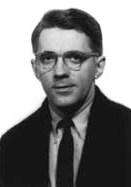David Tudor
| David Tudor | |
|---|---|
|
Tudor circa 1950 | |
| Background information | |
| Born |
January 20, 1926 Philadelphia, Pennsylvania, U.S. |
| Died |
August 13, 1996 (aged 70) Tomkins Cove, New York, U.S. |
| Occupation(s) | musician, composer |
| Instruments | Piano |
| Associated acts | John Cage, Merce Cunningham |
David Eugene Tudor (January 20, 1926 – August 13, 1996) was an American pianist and composer of experimental music.
Life and career
Tudor was born in Philadelphia, Pennsylvania. He studied piano with Irma Wolpe and composition with Stefan Wolpe and became known as one of the leading performers of avant garde piano music. He gave the first American performance of the Piano Sonata No. 2 by Pierre Boulez in 1950, and a European tour in 1954 greatly enhanced his reputation. Karlheinz Stockhausen dedicated his Klavierstück VI (1955) to Tudor. Tudor also gave early performances of works by Morton Feldman, Earle Brown and La Monte Young.
The composer with whom Tudor is particularly associated is John Cage; he gave the premiere of Cage's Music of Changes, Concert For Piano and Orchestra and the notorious 4' 33". Cage said that many of his pieces were written either specifically for Tudor to perform or with him in mind, once stating "what you had to do was to make a situation that would interest him. That was the role he played.”[1] The two worked closely together on many of Cage's pieces, both works for piano and electronic pieces, including for the Smithsonian Folkways album: Indeterminacy: New Aspect of Form in Instrumental and Electronic Music (1959). Tudor also performs on several recordings of Cage's music, including the Mainstream record of Cartridge Music, the recording on Columbia Records of Variations II, and the two Everest records of Variations IV.
After a stint teaching at Darmstadt from 1956 to 1961, Tudor began to wind up his activities as a pianist to concentrate on composing. He wrote mostly electronic works, many commissioned by Cage's partner, choreographer Merce Cunningham. His homemade musical circuits are considered landmarks in live electronic music and electrical instrument building as a form of composition. One piece, Reunion (1968), written jointly with Lowell Cross features a chess game, where each move triggers a lighting effect or projection. At the premiere, the game was played between John Cage and Marcel Duchamp. Reunion is erroneously attributed to Cage in James Pritchett's book The Music Of John Cage.
In 1969, Tudor set up India's first electronic music studio at the National Institute of Design in Ahmedabad.[2]
Upon Cage's death in 1992, Tudor took over as music director of the Merce Cunningham Dance Company. Among many works created for the company, Tudor composed Soundings: Ocean Diary (1994), the electronic component of Ocean, which was conceived by John Cage and Merce Cunningham, with choreography by Merce Cunningham, orchestral music by Andrew Culver and design by Marsha Skinner.
Tudor died in Tomkins Cove, New York at the age of 70.
See also
References
- Notes
- ↑ Holzaepfel, John. "David Tudor and Gordon Mumma". Liner note essay. New World Records.
- ↑ Keefe, Alexander. "Subcontinental Synth: David Tudor and the First Moog in India". East of Borneo. Retrieved 20 May 2013.
External links
- Website
- Finding Aid for David Tudor papers, Getty Research Institute
- Lovely Music Biographies: David Tudor
- Indeterminacy: New Aspect of Form in Instrumental and Electronic Music Album Details at Smithsonian Folkways
- Interviews
- David Tudor interview by Bruce Duffie (April 7, 1986)
